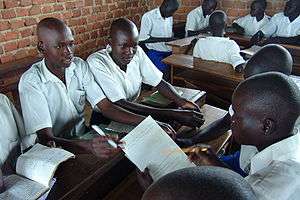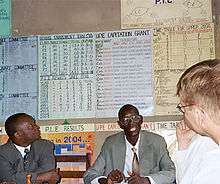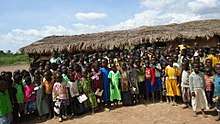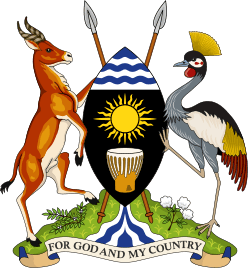Education in Uganda

The system of education in Uganda has a structure of 7 years of primary education, 6 years of secondary education (divided into 4 years of lower secondary and 2 years of upper secondary school), and 3 to 5 years of post-secondary education. The government of Uganda recognizes education as a basic human right and continues to strive to provide free primary education to all children in the country, however, issues with funding, teacher training, rural populations, and inadequate facilities continue to hinder the progress of educational development in Uganda means that education systems aren't the best.[1]
Primary education

The present system of education, known as Universal Primary Education (UPE), has existed since 1997, and its introduction was the result of democratisation and open elections, as there was great popular support for free education.[2] Despite its promising boosts in enrolment, issues with funding and organisation have continued to plague the UPE.[2] In 1999 there were six million pupils receiving primary education, compared to only two million in 1986. Numbers received a boost in 1997 when free primary education was made available to four children per family. Only some of primary school graduates go on to take any form of secondary education. This is contingent upon their passing their Primary Leaving Examinations (PLE).
Uganda is one of East Africa's developing countries, bordered by Tanzania, Rwanda, the Democratic Republic of the Congo, South Sudan, and Kenya. It occupies 236,040 square kilometres (91,140 sq mi) and has 26,404,543 people. According to CIA World Fact Book 2004, more than 80 percent of its population is rural and 35% of the people lives below poverty line (Ngaka 172). The United Nations characterised the current condition of Uganda with its unstable government and struggling people as "the world’s worst humanitarian crisis". (Moyi 6)

In 1997 the Ugandan government introduced the Universal Primary Education (UPE) program to improve enrollment and attainment in primary schools. It was initially realized to provide free education for four children per family, but the program was not performing based in its regulations due to the complex structure of Ugandan families. Most Ugandan families have more than four children and households started sending every child, which resulted in a rapid increase in student enrollment in primary schools (Ngaka 172). Due to the circumstances, President Museveni announced that the UPE was open to all children of all families (Omona 74). When the new policy was executed, schools experienced a massive influx of pupils and the demand for learning materials, teachers, and infrastructure became a challenge to the education system (Ngaka 172). Ngaka argues that the UPE resulted in costly consequences, including but not limited to a poor quality education, low pupil achievement, untrained teachers, improper infrastructures and classroom settings (173).
Uganda has seven years of primary education and the legal age for school entry is six (Moyi 3). According to the Ministry of Education and Sports (MoES) statistics, school enrollments increased from three million to 5.3 million in 1997 and the number rapidly increased to seven million by 2004 (Kakura 137). Even though the increased number of pupils was perceived as a good thing, there were only 125,883 teachers, exceeding the UPE required pupil-teacher ratio of 1:40 (Kakura 138). The large number of pupils worsens the learning environment and it becomes harder for the teacher to be heard and teach. According to Arbeiter and Hartley, classes have between 70 and 150 pupils and there is over-age studying in all schools. Moyi explains the issue of many classes having the inappropriate age of pupils as having been driven by late enrolment or grade repetition, which in turn is caused by the poor quality of education (8). For instance, “third grade included pupils aged between seven to sixteen years and in sixth grade there were pupils up to nineteen years of age” (Moyi 66).
Secondary education
There is a significant disparity between enrolment rates in primary and secondary schools in Uganda. Census data from 2004 indicates that for every ten students enrolled in primary schools, only one is enrolled at a secondary institution.[3] The structure of Uganda's secondary education system follows the education system of its former colonial masters, Britain. It is divided into the Ordinary level and Advanced level. Lower secondary consists of 4 years of schooling at the end of which students undertake Ordinary-level exams (O-level) in at least 8 subjects with a maximum of 10 subjects. Upper secondary consists of 2 years of schooling at the end of which students sit Advanced-level exams (A-level) in at least 3 subjects.
The curriculum for lower secondary is currently being reviewed by the National Curriculum Development Centre, and a new curriculum is expected to be rolled out in 2014 or 2015.
Three-year technical schools provide an alternative to lower secondary school. Alternatives for graduates from lower secondary school include: 2-3 year Technical institutes; 2 year Primary Teacher Colleges (PTC); Department Training Colleges (DTCs) and Upper secondary schools; including:
- Kitante Hill Secondary School - Mixed day school
- St Mary's Secondary School Kitende
- St. Mary's College Kisubi - All boy's boarding school
- Mount Saint Mary's College Namagunga - All-girl boarding school (S1 to S6)
- Kibuli Secondary School - Mixed day and boarding school (S1 to S6)
- Bugema Adventist Secondary School - Mixed boarding school(S1 to S6)
- King's College Budo - Mixed boarding school (S1 to S6)
- Gayaza High School - All-girl boarding school (S1 to S6) - Oldest girls secondary school
- Uganda Martyrs' Secondary School Namugongo - One of the best in the country
- Mengo Senior School - Mixed day school
- Ntare School
- Nabumali High School
- St. Henry's College Kitovu
- Makerere College School
- Comboni College
- Kinaawa High School-mugongo- mixed school
- German Secondary School Uganda[4]
- Kiira College Butiki - Boys' boarding school in Jinja (S1 to S6) founded in 1959
- Ebony College Luwero - Mixed day and boarding school (S1 to S6)
- Seat of Wisdom Secondary School- All-girl day and boarding school (S1 to S6)[5]
- Sseguku Hill College- All-girl day and boarding school (S1 to S6)[6]
- Mackay Memorial College Mixed day and boarding school located in Nateete (S1 to S6)
- Serere Township Secondary School[7]- A Christian private "O" and "A" Level Mixed Day and Boarding School
International schools
- Rainbow International School
- Kampala International School
- [International School of Uganda]]
- [Heritage International School]]
Post-secondary education
Although 60,000 to 70,000 students in Uganda leave secondary school each year qualified to go on to higher education, only some 35 per cent of them (at most 25,000) are able to find places at the limited number of institutions. The majority of students go to universities, both public and private. Makerere University in Kampala has about 95 percent of the total student population in Uganda's universities. The remainder are distributed among the more than 20 private universities and a smaller number of non-university institutions. Recognised universities in Uganda include:
Government universities
- Busitema University
- Gulu University
- Kabale University
- Kyambogo University
- Makerere University www.mak.ac.ug
- Mbarara University of Science & Technology
- Muni University
- Soroti University
Lira university
Religious-affiliated universities
- African Bible University
- All Saints University
- Ankole Western University
- Bishop Stuart University
- Bugema University
- Busoga University
- Islamic University in Uganda
- Kumi University
- LivingStone International University
- Ndejje Christian University
- Uganda Christian University
- Uganda Martyrs University
- Uganda Pentecostal University
Private secular universities
- African Rural University
- Busoga University
- Cavendish University Uganda
- International Health Sciences University
- International University of East Africa
- Kabale University
- Kayiwa University
- Kampala University
- Kampala International University
- Mountains of the Moon University
- Muteesa I Royal University
- Nkumba University
- Royal Open University
- St. Augustine International University
- St. Lawrence University
- Uganda Technology and Management University
- Victoria University
Vocational and technical education
.jpg)
Vocational and Technical Education is a necessary aspect of the education system in Uganda. The UN has led efforts to support this form of education through the UNESCO subdivision International Centre for Technical and Vocational Education and Training (TVET). According to a UN report, "Uganda’s TVET mission is defined as being to ensure that individuals and enterprises acquire the skills they need to raise productivity and income."[8] These TVET programs range in both complexity and scope. Some provide for craftsmen or technician level training that replaces standard modes of secondary education, while some TVET programs provide graduate engineering level education to students seeking education at the tertiary or post secondary level.[8]
Literacy programs
Early literacy movements were characterized by Western aid and leadership and have since given way to a more local decentralized approach to adult and youth literacy in Uganda. This transition is due in part to the realization of leaders in the West and in Uganda that literacy, and literacy in English particularly, is not a silver bullet for solving Uganda’s economic issues.[9] Much of the literacy work is conducted by NGOs acting on a local level in conjunction with local or village governments. There is a great demand for these programs, and their rates of return, satisfaction, and literacy retention for graduates have been high.[10] However, these programs face great challenges including lack of funding, social reluctance, and a general lack of appreciation for literacy and literature.[11][10]
Northern Uganda
Education is important for a successful post-conflict transition in Northern Uganda (see Conflict in Northern Uganda), as it helps develop peoples' abilities to break free of circles of violence and suffering.[12] Uganda's Universal Primary Education (UPE) has resulted in high enrolment rates in Northern Uganda, but education tends to be of a low quality and few pupils actually complete primary school. There are inadequate facilities; e.g. out of 238 primary schools in Pader, 47 are still under trees, limited teacher accommodation is causing high rates of teacher absenteeism and in some areas the average primary school teacher to student ratio is 1:200.[12]
Furthermore, there is some evidence to suggest completion of secondary school is necessary to provide an individual with a proper chance to escape poverty, as employment and income levels for those who completed primary schools are similar to those who did not attend at all.[12] Their region has particular difficulties as teachers are hard to find, the conflict created a lost generation without an adequate education themselves and teachers from other areas are still highly concerned about security in the region.[12]
Female education

Literacy discrepancies and educational inequity are a serious factor in the propagation of gender inequality. Female school attendance at all levels of society in Uganda is lower than that of men, and this can be attributed to poverty, inadequate infrastructure, social pressures, and early maternity.[13] These barriers continue throughout a woman’s life, as one cited challenge to adult females' participation in literacy education in Uganda is home life. A World Bank report found that a significant force in preventing attendance at adult literacy classes was husbands stopping their wives from attending.[10] According to United Nations' Girls Education Initiative statistics, literacy rates for young females still lag behind that of young boys by five percent, and nearly half of all girls in Uganda are married before the age of 18.[14] Uganda received a score of .517 on the UN Development Programme Gender Equality index as reported in the Human Development Report.[14] This measure evaluates the respective equality of women in various dimensions including: health, empowerment, and access to labor market.[15]
See also
References
- ↑ "Education in Uganda". www.globalpartnership.org. Retrieved 2017-11-13.
- 1 2 Stasavage, David (2005). "The Role of Democracy in Uganda's Move to Universal Primary Education". The Journal of Modern African Studies. 43 (1): 53–73. doi:10.2307/3876259. JSTOR 3876259.
- ↑ "Education in Uganda". www.education.go.ug. Retrieved 2017-11-13.
- ↑ "Uganda Laden: Victorian High School". www.germanschool-uganda.com.
- ↑ "seat of wisdom sss kasawo, Kampala, Uganda - www.Graduates.com - Reuniting School Friends". www.graduates.com.
- ↑ http://hellouganda.com/listing/listing.php?id=86 Archived July 25, 2014, at the Wayback Machine.
- ↑ "schoolguideuganda.com". www.schoolguideuganda.com.
- 1 2 UNESCO-UNEVOC International Centre for Technical and Vocational Education and Training. "World TVET Database Uganda." UNESCO, 2014.
- ↑ Twaddle, Michael (2011). "SOME IMPLICATIONS OF LITERACY IN UGANDA". History in Africa. 38: 227–255. doi:10.2307/41474551. JSTOR 41474551.
- 1 2 3 The World Bank. "Adult Literacy Programs in Uganda." The World Bank, 2001.
- ↑ Tembe, Juliet (2006). "Teacher Training and the English Language in Uganda". TESOL Quarterly. 40 (4): 857–860. doi:10.2307/40264317. JSTOR 40264317.
- 1 2 3 4 Kate Bird and Kate Higgins (2009) Conflict, education and the intergenerational transmission of poverty in Northern Uganda London: Overseas Development Institute
- ↑ Atekyereza, Peter R. (2001-01-01). "The education of girls and women in Uganda". Journal of Social Development in Africa. 16 (2): 115–146. doi:10.4314/jsda.v16i2.23876. ISSN 1012-1080.
- 1 2 "United Nations Girls' Education Initiative - Uganda - Snapshot". UNGEI. Retrieved 2017-11-13.
- ↑ "Gender Inequality Index (GII) | Human Development Reports". hdr.undp.org. Retrieved 2017-11-13.
- Ngaka, Willy. Co-Operative Learning In A Universal Primary Education System. International Journal of Learning 13.8 (2006): 171-178. Education Research Complete. Web. 5 Mar. 2014.
- Moyi, Peter. Primary School Attendance and Completion Among Lower Secondary School Age Children in Uganda. Current Issues in Education 16. 2 (2013) : 1-16. Print.
- Kakuru, Doris M. "HIV/AIDS, Children's Rights And Gender Equality In Uganda's Universal Primary Education." International Journal of Learning 14.2 (2007): 137-148. Education Research Complete. Web. 10 Mar. 2014.
- Omana, Julius. Organisational Culture: Uganda’s Inspectorate Department of Education. International Journal of Educational Administration. Vol 2, Number 1. 73-99. 2010. Print.
External links
- Education Statistics and Quality of Education in Uganda, Southern and Eastern Africa Consortium for Monitoring Educational Quality (SACMEQ)
- Ministry of Education and Sports, The Republic of Uganda,
- Education and Sports Sector Fact Sheet 2000 - 2012
- Schools in Uganda
